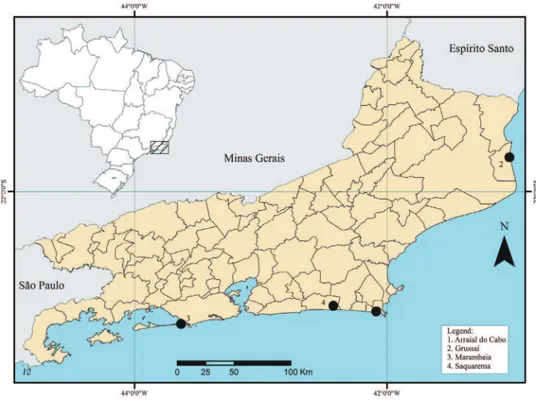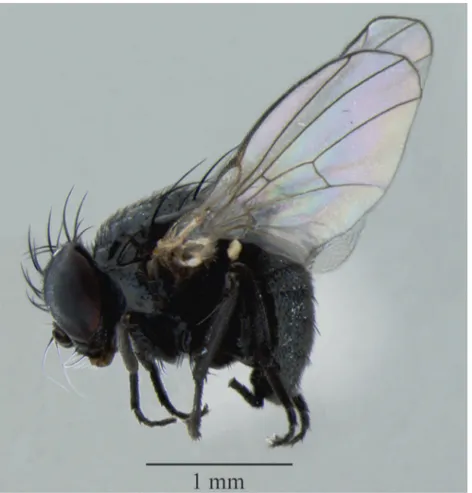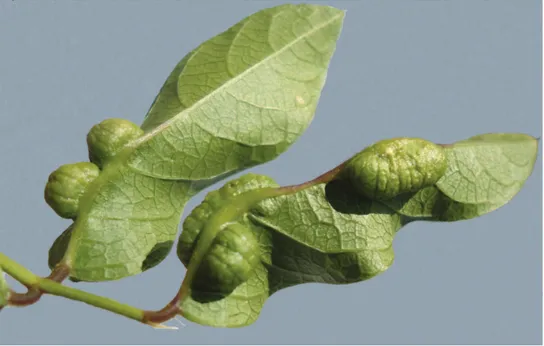Redescription of Japanagromyza inferna Spencer,
first recorded from Brazil, and a key to the
Neotropical species of Japanagromyza
Sasakawa (Diptera, Agromyzidae)
Viviane Rodrigues de Sousa1, Márcia Souto Couri1
1 Department of Entomology, Museu Nacional, Quinta da Boa Vista, São Cristóvão, Rio de Janeiro, 20940-040, Brazil
Corresponding author:Viviane Rodrigues de Sousa (sousavrodrigues@gmail.com)
Academic editor:T. Dikow | Received 3 September 2013 | Accepted 8 January 2014 | Published 28 January 2014 Citation: de Sousa VR, Couri MS (2014) Redescription of Japanagromyza inferna Spencer, irst recorded from Brazil, and a key to the Neotropical species of Japanagromyza Sasakawa (Diptera, Agromyzidae). ZooKeys 374: 45–55. doi: 10.3897/ zookeys.374.6188
Abstract
Japanagromyza inferna Spencer is recorded for the irst time from Brazil, in the North coast of the State of Rio de Janeiro, inducing galls in Centrosema virginianum L. (Fabaceae). he species is redescribed, with illustrations of male and female terminalia. A key to the identiication of the Neotropical species of Japanagromyza Sasakawa is presented.
Keywords
Morphology, taxonomy, insect-plant interactions, gall-inducing, new records
Introduction
Japanagromyza Sasakawa has currently 80 known species in the world (Lonsdale 2013)
and is represented by 30 in the neotropics (Martinez and Etienne 2002, Etienne and Martinez 2003, Sasakawa 2005, Boucher and Hanson 2006, Boucher 2010). Only one species has been recorded from Brazil (São Paulo), J. macroptilivora Esposito & Prado (Esposito and Prado 1993). Some species are known to induce galls in plants, 15 of them are associated with plants of the Fabaceae family (Benavent-Corai et al. 2005) and other species are known to induce mines in crop plants (Spencer and Stegmaier 1973).
Japanagromyza is morphologically similar to Agromyza Fallén and Melanagromyza
Hendel, although its species can be recognized by the following combination of char-acters: halter yellow, white, uniformly dark brown or variegated on top or inside of dark knob; thorax with two pairs of dorsocentral setae (rarely three pairs, but anterior ones only a little longer than acrostichals); one pair of scutellar setae (rarely absent); fore tibia with lateral setae in the middle (see Sasakawa 2010 for a complete description of the genus).
Japanagromyza inferna Spencer was originally described from Bahamas, with no
information on the host plant (Spencer and Stegmaier 1973). Spencer et al. (1992) reported this species from Guadeloupe, also with no data on the host plant. Years later Etienne and Martinez (2003) recorded from Guadalupe and Saint Christo-pher, inducing leaf galls on Centrosema virginianum L. (Fabaceae). C. virginianum
is found throughout South America in forest scrub, “caatinga” and woodlands (Schultze-Kraft et al. 1990). Other species of Agromyzidae recorded as pests in plants of the genus Centrosema Benth. are Ophiomyia centrosematis (Meijere), M.
phaseoli Tryon, causing damage and inluencing plant growth (Lenné et al. 1990),
Japanagromyza centrosematifolii forming mines in C. virginianum and C. pubescens
(Etienne and Martinez 2003) and J. centrosemae Frost, known on C. pubescens
(Spencer 1990).
he main aim of this paper is to present a redescription of J. inferna, including characters not yet described, and a key to the 30 Neotropical species of the genus
Japanagromyza.
Material and methods
Collections were made bimonthly, from July 2011 to March 2012, in sandbanks in the North coast of the State of Rio de Janeiro (Fig. 1). he localities investigated were Arraial do Cabo, Grussaí (São João da Barra) and Saquarema (coordinates under ma-terial examined). In addition to these locations, an extra collection was made in the Marambaia sandbank, also located in Rio de Janeiro (Fig. 1).
To obtain material, branches of the plants with galls were removed and taken to the laboratory. he branches were placed in plastic pots, covered with organza and elastic for rearing and emergence of the adults. After emergence, adults were mounted on entomological pins and were deposited in the collection of Museu Nacional, Uni-versidade Federal do Rio de Janeiro.
Results
Japanagromyza inferna Spencer, 1973
http://species-id.net/wiki/Japanagromyza_inferna
Material examined. BRAZIL, RIO DE JANEIRO: Saquarema: 22°56'06"S, 42°4'43"W. 3 ♂, 1 ♀, 01. VI. 2012. Col. V.R. Sousa; 22°56'03"S, 42°24'16"W. 3 ♂, 3 ♀, 18. XI. 2011. Col. V.R. Sousa; 1 ♂ and 2 ♀, 19 XI 2011. Col. V.R. Sousa. Arraial do Cabo: 22°57'00"S, 42°05'05"W. 1♀, 01. VI. 2012. Col. V.R Sousa. Grussaí: 21°43'42.5"S, 41°01'46.2"W. 1♂, 29. I. 2012. Col. V.R Sousa; 21°44'36.3"S, 41°01'44.7"W. 1♂, 01. II. 2012. Col. V.R. Sousa. Marambaia: 17m 23°02'56"S, 43°37'51"W. 1 ♂, 4 ♀, 03. II. 2012. Col. V.R. Sousa. All forming galls in Centrosema virginuanum (L.) Benth.
Redescription. Male. (Fig. 2) - Body length: 2.5–2.6 mm. Wings length: 2.4mm. Color. Frons black dull, paler brownish at orbits level; face dark; fronto-orbital plate and ocellar triangle shining black; lunule gray pollinose; antenna black with apex of pedicel and base of postpedicel brown; arista black; palpus black; proboscis brown with labellum paler yellow with long yellow setae; thorax black with greenish relec-tions; halters yellow, brown at base; calypters and fringe yellow; legs black with cop-pery relections; pulvilli white; abdomen black with copcop-pery relections.
Head. Fronto-orbital setulae in 4 pairs of rows, the two upper ors longer than the lower ones, irst pair inclinate and the others posteriorly directed; ocellar triangle long; ocellar setae parallel and forward directed; internal orbital seta long, parallel and divergent; external orbital seta with about half the length of the internal; third anten-nal segment rounded and minutely pubescent; arista long and short pubescent; gena shorter with setae; vibrissa strong and short.
horax. Acrostichals in 10 rows, pre-sutural pair diferentiated; two postsutural dorsocentral setae; two notopleural setae; one supra-alar; one intra-alar; one post-alar weak; two prospronotals; two pairs of scutellar setae, one sub basal and one apical, similar in size; four anepisternals with second upper one long and strong; katepister-num with small setae and one long katepisternal.
Legs. Fore tibia with one posterior supramedian seta. Mid tibia with two posterior setae inserted at middle third and one ventral apical seta. Hind tibia with one ventral apical seta.
Terminalia. Epandrium with internal margin with a small median indentation and with long setae; cercal plate with 3-4 spines in the basal portion, eight lateral spines and long cilia in all extension; surstylus long, slightly curved with about four thick spines (Fig. 4). Hypandrium v-shaped (Fig. 5); aedeagus simple, long and tubular, ornamented with membranes at the basiphallus (Fig. 6); ejaculatory apodeme small, hammer-shaped, with weak spines at base (Fig. 7).
Female. Similar to male.
Ovipositor. Dorsal view: cerci with two setae (Fig. 8). Ventral view: ninth tergite with one pair of long setae; egg-guides well sclerotized; two pairs of spiracles (Fig. 9). Spermathecae long and thin (Fig. 10).
Puparium. General color orange-brown (Fig. 11).
Host-plant.Centrosema virginianum. Oval gall on leaf rib. 2–5 pupae on each gall. (Fig. 12).
Distribution. Bahamas, Guadalupe, Brazil (Rio de Janeiro).
Figures 8–10. Female ovipositor of Japanagromyza inferna Spencer 8 dorsal view 9 ventral view
Figure 12. Gall of Japanagromyza inferna in Centrosema virginianum L. (Fabaceae).
Key to Neotropical species of Japanagromyza
1 Pre-scutelar acrostichal setae absent ...2
– Pre-scutelar acrostichal setae present ...5
2 Mesonotum distinctly greenish; two strong ors present; fringe of calypter white; male cerci without strong spines; shape of phallus as in igs 1–4 of Boucher and Hanson 2006 (Host-plant: Lonchocarpus oliganthus) [Costa Rica] ...J. lonchocarpi Boucher – Mesonotum greyish black; other combination of characters ...3
3 Calypter dark grey, margin and fringe black (Host-plant: Polygonum sp.) [Venezuela, U.S.A (Florida)] ...J. polygoni Spencer – Calypter, margin and fringe whitish or silvery white ...4
4 Abdomen greenish grey; arista bare (Host-plants: Desmodium sp., D. tortuo-sum, D. campylocladus) [Colombia, Equador, Peru, Venezuela, U.S.A. (Flori-da)] ...J. desmodivora Spencer – Abdomen shiny bluish black; arista plumose (Host-plant: unknown) [Peru] .. ...J. tingomariensis Sasakawa 5 Mesonotum distinctly greenish ...6
– Mesonotum greyish black ...14
6 Halter with parts brown ...7
– Halter completely yellow or white ...8
7 Frons gray dusted; lunule brown; acrostichals in 8 rows (Host-plant: un-known) [Colombia] ...J. ambigua Sasakawa – Frons black dull, paler brownish at orbits level; lunule gray pollinose; acros-tichals in 10 rows (Host-plant: Centrosema virginianum) [Bahamas, Guada-lupe, Brazil] ...J. inferna Spencer 8 Arista bare (Host-plant: Macroptilium lathyroides) [Brazil] ... ...J. macroptilivora Esposito & Prado – Arista distinctly pubescence or plumose ...9
9 Frons uniformly brown (Host-plant: Vigna luteola) [Bahamas, Cuba, Guada-lupe, La Dominica, U.S.A. (Florida)] ...J. aequalis Spencer – Frons black dull ...10
10 Large species; wing length 3.1 mm; mesonotum uniformly greenish (Host-plant: unknown) [Panama, Porto Rico] ...J. iridescens (Frost) – Smaller species; wing length 1.9 to 2.4 mm; mesonotum greenish or cop-pery ...11
11 Abdomen shiny greenish or faintly bluish; arista slightly pubescent (Host-plant: Vigna luteola) [Cuba, Barbade, Guadalupe, Dominica, Peru, Puerto Rico, Venezuela, Saint-Vicent, U.S.A. (Florida)] ....J. inaequalis (Malloch) – Abdomen strongly shining green; arista distinctly pubescent ...12
Spen-cer and Stegmaier 1973); surstyli extending downward, with about ive short bristles on inner margin (ig. 343, in Spencer and Stegmaier 1973) (Host-plant: Rhynchosia phaseoloides) [Antigua, Barbados, Porto Rico]... ...J. bennetti Spencer
– Male terminalia other that described other above ...13
13 Wing length 1.9 mm; aedeagus relatively short, as a membranous tubule; hypandrium with short, down-curved hypandrial apodeme (ig. 355 (A, B), in Spencer and Stegmaier 1973) (Host-plant: unknown) [Guadalupe, La Dominica] ...J. wirthi Spencer
– Wing length 1.9 to 2.4 mm; aedeagus with basiphallus and median section uniformly but weakly chitinized, distiphallus entirely membranous; hypan-drium rounded, without hypandrial apodeme (ig. 37 (A, B), in Spencer and Stegmaier 1973) (Host-plant: Desmodium tortuosum) [Bahamas, Costa Rica, Dominica, Guadalupe, Puerto Rico, Dominican Republic, Saint Martin, U.S.A. (Florida), El Salvador] ...J. perpetua Spencer
14 Halter entirely brown or black ...15
– Halter stem white or yellow, knob white or black ...16
15 Fore tibia with distinct posterior setae; calypters largely brown or black (Host-plant: unknown) [Panama] ...J. orbitalis (Frost)
– Fore tibia without setae; calypters yellow with margin and fringe pale brown (Host-plant: unknown) [El Salvador]...J. nebulifera Sasakawa
16 Calypters gray with margin and fringe black; halter with knob black; (Host-plant: unknown) [Jamaica] ...J. jamaicensis Spencer
– Calypters yellow with margin and fringe black or yellow; halter with knob yellow or black ...17
17 Palpus yellow and abdomen with yellow areas ...18
– Palpus brown to black; abdomen normally shining black ...19
18 Frons black dull behind, brownish in front; fringe of calypters yellow; aedeagus with distiphallus as a curve tubule with small, paired processes at end (Host-plant: unknown) [Cuba, Cayman Islands, Jamaica] ...J. maculata (Spencer)
– Frons black dull, paler, more yellowish in front; fringe of calypter dark brown; aedeagus with distiphallus large, paired terminal processes (Host-plant: un-known) [Bahamas, Guyana, Jamaica]...J. spadix (Spencer)
19 Knob of halter dark black ...20
– Knob of halter white or yellow ...21
20 Arista conspicuously pubescent; mid tibiae with two posterodorsal setae (Host-plant: unknown) [Guatemala, Panama] ...J. aldrichi (Frick)
– Arista almost bare or microscopically pubescent; mid tibiae with one postero-dorsal setae (Host-plant: unknown) [Guatemala] ... ...J. approximata(Frost) (new comb. by Sasakawa 2005) 21 Fore and mid tibiae without distinct setae (Host-plant: Centrosema puben-cens) [Panama] ...J. centrosemae (Frost)
22 Fore tibia with one anterodorsal seta and mid tibia with two strong pos-terodorsal setae (Host-plants: Centrosema virginianum, Centrosema pubescens) [Guadalupe, Saint-Christopher] ...J. centrosematifolii Etienne
– Fore and mid tibiae with setae present but diferent disposition on anterodor-sal and posterodoanterodor-sal ...23
23 Fringe of calypter silvery ...24
– Fringe of calypter white or yellow ...26
24 Aedeagus with long straight distiphallus; cerci without setae (ig. 40, in Spen-cer and Stegmaier 1973) (Host-plants: Castanea sp., Quercus rubra, Quercus
spp. [Puerto Rico, Gulf of Mexico, Canada, U.S.A. (Florida)] ... ...J. viridula (Coquillett)
– Aedeagus with two coiled tubules; cerci large, with numerous strong setae 25
25 Length of the wing about 1.75 mm; spines on cercus and surstylus not numer-ous (ig. 2 in Martinez 1994) (Host-plants: Phaseolus lunatus, Phaseolus sp.) [Guadalupe, Jamaica, Saint-Christopher, Saint-Martin] ...J. etiennei Martinez
– Length of the wing from 2.5-2.75 mm; spines on cercus and surstylus numer-ous (ig. 20 in Spencer 1983 (Host-plants: Phaseolus spp., Phaseolus vulgaris) [Argentina, Costa Rica, Peru, Venezuela] ...J. phaseoli Spencer
26 Antennae light brown, with postpedicel darkened distally (Host-plant: un-known) [El Salvador] ...J. arnaudi Sasakawa
– Antennae entirely black ...27
27 Arista bare; spines on cerci and aedeagus as in igs 9-10 of Spencer 1963 (Host-plant: unknown) [Costa Rica] ...J. frosti (Frick)
– Arista pubescence or plumose; spines and aedeagus diferent from above ..28
28 Mesonotum shining black, without relections...29
– Mesonotum black with coppery relections (Host-plant: unknown) [Baha-mas] ...J. propinqua Spencer
29 Abdomen black strongly shining; arista pubescent (Host-plant: unknown) [Colombia] ...J. clausa Sasakawa
– Abdomen opaque dark brown; arista distinctly plumose (Host-plant: un-known) [Panama] ...J. currani (Frost)
Acknowledgments
References
Benavent-Corai J, Martinez M, Peydró RJ (2005) Catalogue of the hosts-plants of the world Agromyzidae (Diptera). Bolletino di Zoologia agrarian e di Bachicoltura serie II (37): 1–97. Boucher S (2010) Agromyzidae (leaf-mining lies). In: Brown BV, Borkent A, Cumming JM,
Wood DM, Woodley NE, Zumbado MA (Eds) Manual of Central American Diptera. NRC Research Press, Ottawa, Ontario, Canada, 1057–1071.
Boucher S, Hanson P (2006) A new Costa Rican species of Japanagromyza (Diptera: Agromyzidae) forming galls on Lonchocarpus (Fabaceae). Proceedings of the Entomological Society of Wash-ington 108 (1): 9–13. http://www.biodiversityheritagelibrary.org/part/69090#/summary Esposito MC, Prado AP (1993) New species of Japanagromyza and Galiomyza (Dipt.,
Agro-myzidae) from Brazil. Entomologist´s Monthly Magazine 129: 239–244.
Etienne J, Martinez M (2003) Les Agromyzidae de Guadalupe: espèces nouvelles et notes addi-tionelles (Diptera). Nouvelle Revue d´entomologie (nouvelle série) 3: 249–272.
Lenné JM, Sonoda RM, Lapointe SL (1990) Diseases and pests of Centrosema. In: Schultze-Kraft R, Clements RJ (Eds) Centrosema: Biology, Agronomy, and Utilization. Centro in-ternacional de agricultura tropical, Cali, Colombia, 175–207.
Lonsdale O (2013) Japanagromyza Sasakawa (Diptera: Agromyzidae) of Africa. Zootaxa 3709 (5): 445–460. doi: 10.11646/zootaxa.3709.5.3
Martinez M (1994) Japanagromyza etiennei n. sp. (Diptera, Agromyzidae) Ravageur potentiel des Phaseolus spp. (Leguminosae) dans les Caraibes. Revue française d’ Entomologia, (N.S) 16 (2): 81–85.
Martinez M, Etienne (2002) Liste systématique et biogéographique des Agromyzidae (Diptera) de la région néotropicale. Bollettino di Zoologia Agraria e di Bachicoltura serie II 34 (1): 25–52. Sasakawa M (2005) he Neotropical Agromyzidae (Insecta: Diptera): Part 6 New or
litt-le-known species from El Salvador and Guatemala. Species Diversity 10: 151–169. Sasakawa M (2010) A review of the Oriental Japanagromyza Sasakawa (Diptera: Agromyzidae),
with descriptions of four new species. Zootaxa 2485: 16–32.
Schultze-Kraft R, Williams, RJ, Coradin L (1990) Biogeography of Centrosema. in: Schultze-Kraft R, Clements RJ (Eds) Centrosema: Biology, Agronomy, and Utilization. Centro in-ternacional de agricultura tropical, Cali, Colombia, 29–53.
Spencer KA (1963) A Synopsis of the Neotropical Agromyzidae (Diptera). Transactions of the Royal Entomological Society of London 115: 291–389. doi: 10.1111/j.1365-2311.1963.tb00811.x Spencer KA (1983) Leaf Mining Agromyzidae (Diptera) in Costa Rica. Revista de Biologia
Tropical 31 (1): 41–67.
Spencer KA (1990) Host Specialization in the World Agromyzidae (Diptera). Kluwer Acade-mic Publishers, Netherlands, 443 pp. doi: 10.1007/978-94-009-1874-0
Spencer KA, Martinez M, Etienne J (1992) Les Agromyzidae (Diptera) de Guadeloupe. An-nales de la Société Entomologique (nouvelle série) 28 (3): 251–302.


